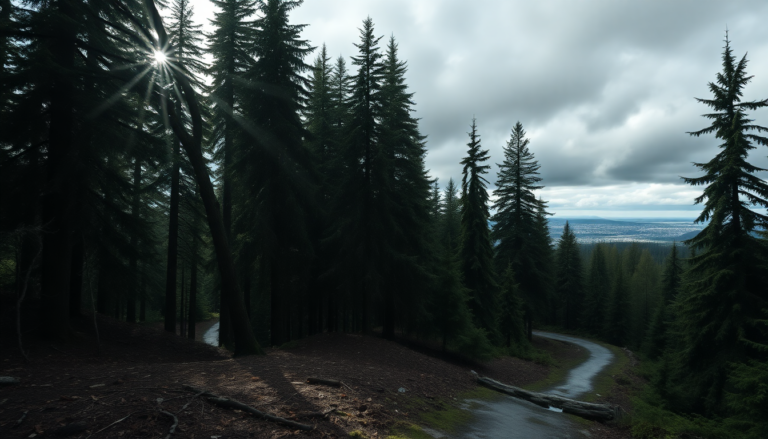Argomenti trattati
Have you ever wondered where the spine-tingling thrills of a horror film are crafted? In the case of the much-anticipated *Final Destination: Bloodlines*, the answer lies within the lush forests and urban nooks of Vancouver. This sixth installment of the franchise is not just about supernatural horror; it’s a showcase of breathtaking landscapes that amplify the tension and eeriness of the story. As we delve into the film’s haunting locations, we uncover how the natural beauty of British Columbia intertwines with its chilling narrative.
The haunting plot of Final Destination: Bloodlines
Set against the backdrop of the stunning yet foreboding landscapes of Vancouver, *Final Destination: Bloodlines* follows eighteen-year-old Stefani, who is plagued by nightmares of a tragic accident from the 1960s. Struggling with sleepless nights at college, she soon discovers that these dreams are not mere figments of her imagination but premonitions linked to her grandmother, Esther, who once evaded death decades ago. As the story unfolds, Stefani and her family realize that they are not safe; Death is coming for them, and they must find a way to stop this relentless force before it’s too late.
What I find fascinating is how the film’s premise taps into our primal fear of the unknown while grounding it in a very real and recognizable environment. The juxtaposition of ordinary settings with extraordinary horror creates an unsettling contrast that keeps viewers on the edge of their seats.
Vancouver: A cinematic haven
Vancouver has long been a favorite among filmmakers, particularly for horror and thriller genres. Its versatile urban landscapes and surrounding natural beauty provide the perfect canvas for crafting eerie atmospheres. For *Bloodlines*, the production team made excellent use of both the bustling cityscape and the dense, mystical forests. While many scenes were shot in the heart of Vancouver, the outskirts and nearby parks offer an idyllic yet haunting backdrop that resonates with the film’s themes.
Having visited Vancouver myself, I can attest to the enchanting quality of its forests. Just a short drive from the city, you can find yourself enveloped in towering Douglas firs, western red cedars, and a rich tapestry of moss and lichen. Locations like Pacific Spirit Regional Park, Lynn Canyon Park, and Capilano River Regional Park are not just beautiful; they evoke a sense of mystery and intrigue. It’s easy to imagine how these places can transform into the eerie settings where life and death collide in the narrative of *Bloodlines*.
Iconic filming spots and their significance
One notable location featured in the film is the H.R. MacMillan Space Centre. This real-life museum, with its distinctive architectural design, serves as a striking focal point in the film. The luxurious restaurant that makes a dramatic appearance is digitally recreated but is inspired by the actual venue atop the Space Centre, offering a stunning view of the city. I remember standing outside this very building, gazing up at the dome, which resembles a woven hat—a nod to the Indigenous cultures of the Pacific Northwest. It’s fascinating how the film intertwines local culture with its horror elements.
Interestingly enough, as director Adam Stein pointed out, the franchise has a tradition of showcasing Vancouver’s landmarks. From the Lions Gate Bridge’s infamous collapse in *Final Destination 5* to the iconic logging trucks in *Final Destination 2*, the city has always been a character in its own right. Each location not only enhances the visuals but also adds layers of cultural significance to the film.
Behind the scenes: Production challenges and triumphs
Despite facing delays due to a general strike, the production team persevered, ultimately completing filming in the spring of 2024. Christian Sebaldt, the director of photography, played a crucial role in capturing the film’s intense visuals. The opening sequence, which takes place at a rooftop restaurant, is a brilliant blend of digital effects and real locations, showcasing how technology can complement the natural beauty of Vancouver.
As I reflect on the challenges the team faced—like navigating the ever-changing weather of British Columbia—I can’t help but admire their dedication. Filmmaking is not for the faint of heart, especially in a genre where every detail counts. The meticulous attention to the settings adds an authenticity that resonates with viewers, pulling them deeper into the story.
Vancouver’s lesser-known spots, like the tranquil yet eerie trails of its surrounding forests, invite exploration. For the adventurous traveler, these places offer the perfect escape from the urban hustle, allowing you to step into the scenes of *Final Destination: Bloodlines*. Imagine wandering through the misty paths, feeling the thrill of being in a film set—but without the impending doom, of course! It’s a unique way to connect with the film’s essence while enjoying the serene beauty of nature.
In my view, the film does an excellent job of celebrating Vancouver’s landscapes while weaving a story that taps into universal fears. The natural world becomes a silent yet powerful character, amplifying the tension and enhancing the horror. As many know, there’s something deeply unsettling about nature when it’s juxtaposed with human fragility.

